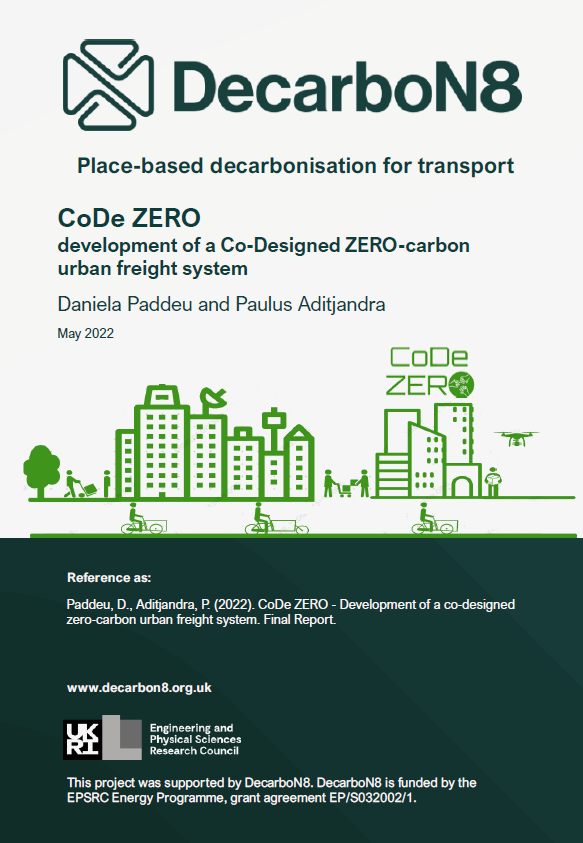
CoDe ZERO: Development of a Co-Designed ZERO-carbon
urban freight system
Authors: Daniela Paddeu and Paulus Aditjandra (2022)
PDF (26 pages, 1 MB)
The aim of this project was to understand challenges and opportunities of freight decarbonisation in urban areas in the North of England, considering the perspective of key freight stakeholders based in the North. The main output of the project is a co-designed roadmap with a series of solutions to achieve urban freight decarbonisation by 2040. Findings show that stakeholders understand the importance of decarbonising urban freight to achieve the net zero target by 2050 (or even sooner) but believe there are a series of challenges, mainly related to the development of efficient cleaner technological solutions and to behaviour/organisational change.
Key Findings
The results of the literature review and the stakeholder engagement workshops informed the design of the urban freight decarbonisation roadmap for the North of England.
Stakeholders see micro-mobility, which includes e-cargo bikes, as a quick win to reduce carbon emissions due to urban goods movements. This solution already exists, and it is implemented in different European cities. However, stakeholders acknowledged that the operational and cost efficiency of this solution would depend on the type of application. For example, despite working well in urban areas, e-cargo bikes might be not convenient for last-mile deliveries to rural areas, due to the limited capacity and the longer distances (compared to urban deliveries). Thus, it would be useful to understand what the ideal scenario (e.g., distance, load factor, type of goods, topography) is to make micro-mobility a competitive alternative. In addition, a large-scale implementation of this solution would require interventions on land use and urban planning, including interventions on road space design.
Stakeholders also believe that urban freight consolidation has the potential to reduce carbon emissions, due to a reduced number of vehicles, and can be an available option in five-to-eight years. They believe that businesses (e.g., retailers and logistics operators) might be resistant to adopt this new delivery scheme as they would need to share data and resources with their competitors, and also because it might not be suitable for all types of goods (e.g., heavy, bulky). In addition, the urban consolidation hub would add extra costs to the chain, which would reduce the attractiveness of this solution, especially because margins of last-mile deliveries are very low. Other major barriers would be “competition”, “brand protection and recognition” and “reputation”. Also, in terms of operations, freight companies might have different logistics models (e.g., return, repair, recycle) and having multiple-operators involved would increase the complexity of the system. Stakeholders are quite positive towards the idea that these barriers might be (at least partially)
overcome before 2030 with the right support from local and central governments to foster collaboration.
Another quick win identified by stakeholders was rapid rail logistics, especially to deliver large volumes of goods into the city centre (e.g., construction sites). Stakeholders believed this could be implemented soon, as the use of inter-city trains can be shared to move people and goods, due to the impact of the pandemic (and the related increasing homeworking post-pandemic) on commuting that created an opportunity in terms of increased spare capacity of trains.
In terms of clean technologies, electrification was considered the way forward to achieve urban freight decarbonisation. Considering that well performing electric vans are already available in the market, stakeholders believed that these could be increasingly used within the next 10 years to fully replace the current diesel fleet by 2030. However, the current technology does not offer viable efficient alternatives for bigger/heavier vehicles (e.g., heavier than 7.5 tonnes), and therefore stakeholder believed electric HGVs might be available in 10-15 years (by 2035). In the meantime, they suggested hydrogen might play a key role as an interim (medium-term) solution to reduce carbon emissions from HGVs. However, even in this case, more research and trials would be needed to support the development of a clean technology for production and propulsion.
New clean fuels, such as biogases, Compressed Natural Gas, Liquefied Natural Gas and similar, were considered a quicker and easier solution, as they can be immediately used as a valid alternative to diesel, until electricity and hydrogen (or zero emission fuels/energy) are available.
Finally, collaborative procurement between retailers, logistics operators and public bodies was seen as a good solution to optimise the overall urban flows, and reduce the demand for loading/unloading locations, kerbside loading/unloading nuisance and therefore reducing related congestion/nuisance to normal functioning of the road network. However, similarly to consolidation, this solution would imply a number of challenges, especially related to willingness to share data, resources, customers with competitors and would also represent a major barrier to new market entrants.
Interestingly, new technologies such as autonomous trucks and robots, or aerial drones were not identified as effective solutions to decarbonise urban freight. Stakeholders acknowledged that they could reduce costs of operations and would therefore represent an indirect solution to invest in clearer alternative delivery options. However, new technologies alone would not be a priority among the solutions to decarbonise urban freight
